The Beauty of Lightning
Article and Photography by Tyson Rininger
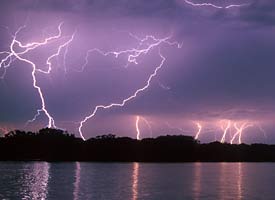 In
the blink of an eye, Nature can turn the night skies into day.
Just in case you were blinking, she'll let you know of her powers
with an ominous roar. Everyone is affected by lightning in some
way, be it the child who can't be pried from the windowsill or
the little brother stuck under the bed. Perhaps it is the mother
consoling her 6-year-old daughter after the power was knocked
out or the firefighter on his way to a new brush fire.
In
the blink of an eye, Nature can turn the night skies into day.
Just in case you were blinking, she'll let you know of her powers
with an ominous roar. Everyone is affected by lightning in some
way, be it the child who can't be pried from the windowsill or
the little brother stuck under the bed. Perhaps it is the mother
consoling her 6-year-old daughter after the power was knocked
out or the firefighter on his way to a new brush fire.
Living in California, not many of these storms
arise, but when they do, their power and animated life become
the talk of the town the next morning. The best part of these
mysterious creations is that no one is able to agree on how those
spectacular bolts looked. Some say they streaked across the sky
from one cloud to another. Others insist these strings of light
rose from the ground disappearing into the clouds and then there
are those who simply saw the clouds light up and nothing more.
I have to agree with all of them.
Lightning bolts are remembered as bright streaks
of jagged light yet, there is so much more to them as only a photograph
could show. Working in a camera store for many years, I see numerous
valiant efforts in trying to capture lightning on film, but few
know how.
In the world of photography, lightning is unique. On any given
morning, you can rise before the sun and choose to photograph
a flower that blooms this time of year. Or perhaps, try to capture
the morning mist rising from the pond nearby, for the fourteenth
time. With very few exceptions, can you decide to photograph lightning
when you feel like it. It just happens. Be ready. Be prepared.
Be smart.
I think back to one particular time when I was
photographing lightning and always laugh at the memory. There
I was, standing on the shore of the Elkhorn Slough, a marshy estuary
half way between Monterey and Santa Cruz, California. I had my
trusty aluminum tripod with my camera atop and cable release in
hand. The cell phone rings, "You getting all this?"
asks a friend. Not only should I have been struck by lightning
- repeatedly, but also my odds of winning the lottery must have
improved ten fold.
Safety. Rule #1 (through however many you can think of): Never
stand next to a large body of water surrounded by trees grasping
an aluminum 'lightning rod' while talking on a cell phone during
a thunder storm. Since that time, I have been turned down by six
life insurance providers and have undergone intense mental studies.
I'm better now.
Wooden tripods have become my best friends along
with lengthy cable releases. No longer do I wear steel-toed shoes
or metal belt buckles. Both of those are good conductors of electricity.
They may not be the cause of getting struck, but heaven forbid
that should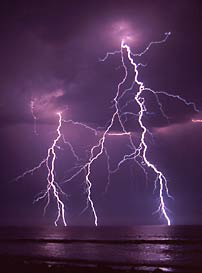 happen, any metal on the body might result in serious additional
burns. I have also learned to sit in the truck when photographing.
The rubber tires prevent the vehicle from becoming a direct conductor
to the ground. Most importantly, no matter how strong the desire
may be to keep dry, never stand beneath a tree. Besides, the branches
will get the way of an otherwise great photograph.
happen, any metal on the body might result in serious additional
burns. I have also learned to sit in the truck when photographing.
The rubber tires prevent the vehicle from becoming a direct conductor
to the ground. Most importantly, no matter how strong the desire
may be to keep dry, never stand beneath a tree. Besides, the branches
will get the way of an otherwise great photograph.
These are just some of the tips I have learned
to adhere to over time without becoming too paranoid. Although
some may say that I'm the first to take a risk in an effort to
obtain that perfect photo, I'll never lose sight of the fact that
I'm still around to do so.
So let's get to the fun stuff already!!!
Film. Film has always remained
a personal preference. Some are loyal to only one type, while
others choose a plethora of styles. If black and white is your
forte, Ilford's Pan F 50 would be a good choice. This film has
an incredibly fine grain structure as well as extreme contrast
values. When it comes to color, the Fuji Velvia rated at ISO 50,
Fuji Provia 100F and Kodak's E100 VS can produce vibrant colors
beyond what we can see with the naked eye. Plus, these films are
incredibly fine-grained.
With few exceptions, I have managed to stay away
from print films since most come out murky or difficult to control
as far as detail is concerned.
Don't be afraid to experiment. Reciprocity characteristics
are what enable film to record lightning in such vivid colors.
These characteristics vary by film type, so try 'em all 'til ya
find one you like.
Equipment. You've probably taken
a moment to browse through the photos to see if this article was
worth your time. If you've made it this far, I think it's safe
to assume that you too would like to create images like these.
Sorry, won't happen. You see that's what makes lightning such
a thrill to photograph. We've all seen the clichés, the
poppy field, Half Dome and those two white wooden lawn chairs
beneath the bent palm tree in the Bahamas. Instantly, pictures
came to mind, huh? But, when you think of lightning, is there
any one photo that you can think of? Probably not. Well here's
your chance to break away from the clichés.
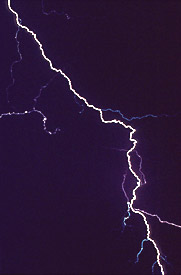 First,
you need a camera. In my opinion, there are only two types that
will work in the 35mm size. A completely manual camera such as
the venerable Pentax K1000, Ricoh KR-5 series or the Nikon FM-10
or, second, a professional weather resistant SLR like the higher
end Canons or Nikons combined with their pro lenses.
First,
you need a camera. In my opinion, there are only two types that
will work in the 35mm size. A completely manual camera such as
the venerable Pentax K1000, Ricoh KR-5 series or the Nikon FM-10
or, second, a professional weather resistant SLR like the higher
end Canons or Nikons combined with their pro lenses.
Why? When there is lightning, generally, there is rain. In the
older manual cameras, there is very little circuitry to be ruined
by the weather. This, of course, does not guarantee your camera
is invincible. If you happen to be in an area that receives 8
inches of rain in 14.3 seconds, no warranty will cover the removal
of fish between the optics of your lens. However, if you are cautious
about the amount of elements your equipment is exposed to, you
should have no problems enjoying the thrill of photographing lightning
again and again.
No matter whom you talk to in the photo industry,
they will tell you water is bad. They are 100% correct. If you
can avoid water, do so. If you can't avoid water, remember to
wipe down your equipment thoroughly and immediately. I have tried
everything to protect my equipment by using Zip Lock bags to trash
bags, all of which caused more hassles than it was worth. Which
brings us to the professional line up.
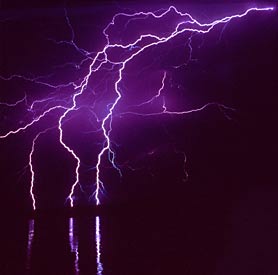 I
personally use Canon's EOS-1V due to its resilience against the
elements, and a 70-200 f/2.8 for the same reason. Of course, what
idiot would ever think of leaving that type of outfit in the rain?
Need I refer back to the 'lightning rod' incident? O.K., it was
an accident. I left it on the roof of my truck overnight after
unloading equipment. After all, it's not supposed to rain in California,
right? In the morning, the camera performed flawlessly, and to
this day, it has seen many storms and braved them successfully.
Kudos to Canon. One major reason for using the 70-200 2.8 instead
of a wider lens, is the enormous lens hood that protects the front
element from any water that may ultimately distort the image.
I
personally use Canon's EOS-1V due to its resilience against the
elements, and a 70-200 f/2.8 for the same reason. Of course, what
idiot would ever think of leaving that type of outfit in the rain?
Need I refer back to the 'lightning rod' incident? O.K., it was
an accident. I left it on the roof of my truck overnight after
unloading equipment. After all, it's not supposed to rain in California,
right? In the morning, the camera performed flawlessly, and to
this day, it has seen many storms and braved them successfully.
Kudos to Canon. One major reason for using the 70-200 2.8 instead
of a wider lens, is the enormous lens hood that protects the front
element from any water that may ultimately distort the image.
In the medium format realm, I use a Hasselblad
500C/M with either a 50mm or an 80mm lens. This camera serves
the same purpose as the mechanical 35mm in that it has no circuitry.
The reasoning for the choice of lenses is that I am already using
a slight telephoto on the 35mm set up. This gives me an opportunity
to capture the textured sky as the bolts light up the clouds above.
Also, the sharp Carl Zeiss lenses enable me to crop tighter if
need be. The only downside is the lack of protection on the front
element from water.
As far as 4x5 goes, have a blast. I never use mine in the rain
simply because there are too many entrances for the water to reach
the film. When it is not raining, I prefer either a 90mm or a
150mm. Basically the same as medium format. Just remember to mark
your infinity focus point on the rails before you go out. Trying
to find infinity in the dark is pretty difficult!
A final camera of choice that could suffice, if
need be, would be the 35mm Pentax IQZoom 90WR, 38-90, all-weather
point-and -shoot camera, or it's replacement, the IQZoom 105WR.
Simply set the cameras at their widest angle and attach a C-clamp
enabling the shutter to remain depressed. Most of the Pentax line
of point-and-shoot cameras have 'bulb' capability however, there
is nothing to keep water from hitting the front lens element.
This may result in slightly distorted images.
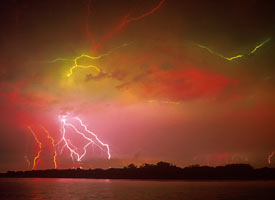 Regardless
of what camera system you choose it must have a bulb setting and
shutter release capability. Other necessities include a wooden
tripod and a fairly long shutter release. Optional items you may
want to consider bringing with you would be an assortment of filters,
flashlight, umbrella, radio and even a chair if your vehicle isn't
around.
Regardless
of what camera system you choose it must have a bulb setting and
shutter release capability. Other necessities include a wooden
tripod and a fairly long shutter release. Optional items you may
want to consider bringing with you would be an assortment of filters,
flashlight, umbrella, radio and even a chair if your vehicle isn't
around.
Why do I need a chair? Photographing lightning
will probably be the easiest thing you've ever done. Here's the
secret. Set up your camera in the direction of the cell that is
producing the most ruckus. You may have to wait for a couple of
bolts to appear before you can determine this. For 100 ISO film,
set your aperture to F/8, open the shutter on the 'bulb' or 'B'
mode, lock the shutter release to keep the shutter open, then
go inside and hunt for your favorite episode of 'West Wing'. It's
that simple.
Unless you live near a city where the sky is illuminated
by artificial light, you should be able to keep your shutter open
for five minutes or more. But wouldn't more than one bolt of lightning
overexpose my picture? Imagine placing your camera in a pitch-black
closet. No matter how long you keep the shutter open, the camera
will only continue to record darkness which is, well, black. Now
imagine you've just popped the flash. Besides being blind and
doing something only I would do, you have also enabled the surrounding
area to become bright enough to record an image on film.
Lightning is the same way, only more centralized. The bolts provide
the fill in light necessary to recording the image, only the emanating
light from the bolts are more controlled than a haphazard flash
bulb. However, nature does provide her form of haphazard flashes.
If the sky should light up repeatedly without bolts of lightning,
you do run the risk of overexposing the image. After all, the
bolts are what provide the impact for a successful photo. The
more bolts that can be recorded on film, the more impact the photo
will bring.
This is where the chair comes in. Have a seat. Enjoy.
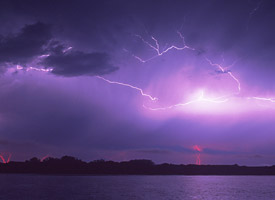 Cool
Tricks. Now that you're a pro at shooting lightning, try throwing
some curves into play. Remember those filters? Use 'em. Open your
lens one half stop and stick that yellow in front. Wait a couple
a bolts then open your lens an additional two and a half stops
and put that #25 red in front. Next, try an #80A blue, then close
it one stop and try a green. You could go on forever! All that
work for one frame of film. When you get your photos back, they
should resemble the surface of some unknown planet with multicolored
streaks of lightning. Just remember to compensate your aperture
for the varying densities of the filters.
Cool
Tricks. Now that you're a pro at shooting lightning, try throwing
some curves into play. Remember those filters? Use 'em. Open your
lens one half stop and stick that yellow in front. Wait a couple
a bolts then open your lens an additional two and a half stops
and put that #25 red in front. Next, try an #80A blue, then close
it one stop and try a green. You could go on forever! All that
work for one frame of film. When you get your photos back, they
should resemble the surface of some unknown planet with multicolored
streaks of lightning. Just remember to compensate your aperture
for the varying densities of the filters.
Be creative. Set up your vehicle in front of the
camera with you posing. The lightning in the background should
make for some pretty killer business cards.
Yet another trick! Say you've just finished shooting
a great lightning storm with a medium format or large format camera.
Unfortunately, the cell causing most of the lightning moved way
over to the right.Rather than chucking the image, cut it! Take
out the scissors and cut it down to the next frame size. Large
format becomes medium format and medium format becomes 35mm. No
one can predict where the lightning is going to strike, but by
using this method, you have a second chance to compose the image
the way you want it to be.
Common sense. As statistics try
to point out, you have a greater chance of being struck by lightning
than you have of winning the lottery. Although I personally have
nothing to back this up, I have heard rumors of people winning
the lottery. This brings me to the conclusion that, for one, statistics
suck, and two, those of us who ignore common sense are quickly
reminded of who is in charge (pun intended).
Almost all of the images presented were photographed
during the early morning hours of an ironic, 9/9/99, storm in
Central California. The last storm of comparison, in that area,
occurred over eighteen years ago.
About the Author: Tyson
Rininger is a professional photographer who lives and works in
Monterey, California. Tyson photographic specialties are in commercial,
motor sports, and jouralism.
You can see more of Tyson's work at these websites:
Click
to see Tyson's Profotos Portfolio
Click
to see Tyson's Website










